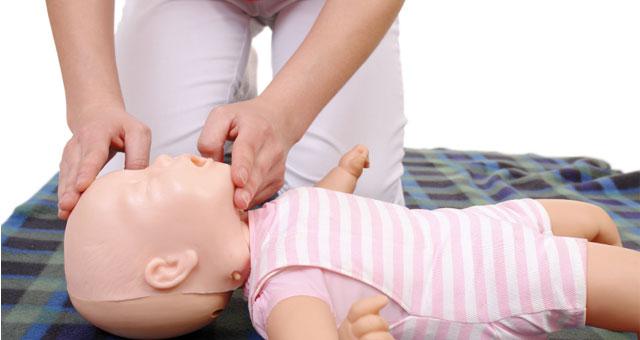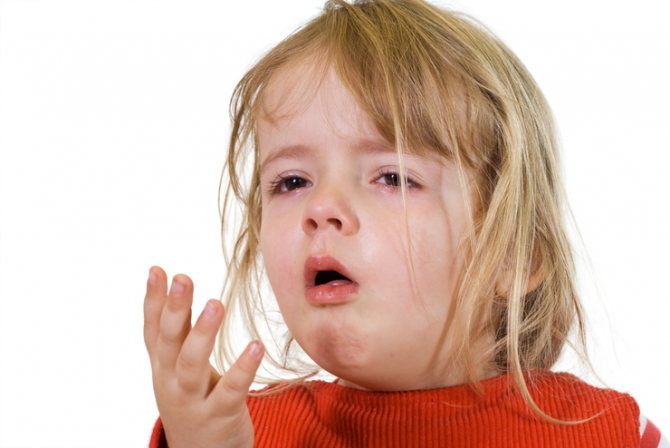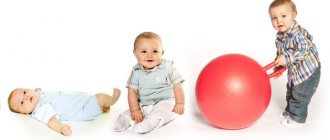09/24/2016 Nadezhda Plotnikova 2 comments
A child is an extremely restless and inquisitive creature. Many different objects pass through his hands, but if the baby is still very small, then all of them are necessarily studied “by heart.”
This behavior risks swallowing small parts and getting them into the respiratory tract. A baby under one year old can choke on breast milk or formula while feeding, and an older baby can choke on pieces of food.
What to do if a child chokes? What should be the first aid? When is it better not to interfere? Every parent needs to clearly understand the sequence of actions in an emergency situation, since the child’s life depends on correct behavior.
When should you intervene?
If you suspect that your child has choked, first of all, remain calm and do not panic or become hysterical. Before giving him first aid, try to look at the situation rationally (of course, this is extremely difficult) and get rid of unnecessary emotions.
The human body is largely an autonomous system that can independently get rid of various liquids and solid objects that have entered the respiratory system. For example, using the cough and gag reflex.
If a small child who has choked coughed and cried and started vomiting, it means that everything is not so bad. He breathes because there is no obstruction in the airway. Therefore, first of all, it is necessary to calm the little one and determine what he choked on.
Most often, small pieces of food and drinks are expelled through vomiting and coughing. Of course, after everything that happened, the baby will not immediately come to his senses, he will cough and feel chest discomfort. However, then, after an hour or two, the condition returns to normal.
What should you do if a child chokes on a bead or a larger piece of food, but continues to breathe? There is no need to try to get the foreign object out on your own, since you will only push it further through inept actions.
Calm the baby and make sure he is breathing, lay him on his side with his chin up, and then call an ambulance.
Emergency first aid from parents is necessary if the following adverse symptoms are observed:
- the child begins to choke, tries to catch air in his mouth;
- first his skin turns red, then turns blue;
- the mouth opens and saliva flows out;
- the baby tries to wrap his arms around the neck (this is what children older than one year do);
- he is not able to talk, cry (if he is a newborn), this is a sure sign of blockage of the airways.
The worst sign is that the baby feels so bad that he loses consciousness. In this case, you can only help with quick and at the same time well-thought-out actions.
What to do if a child chokes - possible consequences
It happens that a foreign body slips through the glottis, but does not come out, but remains in the trachea. This will not lead to death, but it can also have very serious unpleasant consequences, including disability...
The fact is that a foreign object in the trachea is attached to its wall.
Gradually, a capsule will form around it, which, as it increases, will interfere with normal breathing and contribute to the onset of long-term inflammatory processes.
In the first weeks, this state of affairs can only be indicated by a rare cough, which is unlikely to be associated by any of the parents with a missing piece of a construction set or another swallowed object.
In the future, the cough may intensify and become painful, with sputum that practically does not come out, and with “whistles” when exhaling.
A little later, in the absence of proper treatment, bronchitis or pneumonia occurs.
The chances that by this moment the parents will remember about the possible entry of a foreign object into the baby’s throat are negligible. Moreover, about 3 months have already passed since the “infection”, or rather, the ingestion of a small object that got into the glottis and settled there.
It happened that such unnecessary guests in the body caused a clinical picture of oncological diseases, which, in turn, gave rise to the development of chronic processes in the child’s lungs.
First aid for an infant
Typically, a newborn or infant under one year old may choke when feeding - milk, food, water, drool. The most common reasons for this situation are:
- incorrect position of the baby when feeding;
- too long a gap between meals (the baby will choke);
- too much milk flow from the breast (the baby does not have time to swallow and chokes);
- large holes in the nipples (if the baby is artificial).
At the same time, the month-old baby will begin to cough heavily, snort, or breathe rapidly. In children several months old, the signs usually do not differ. To help infants, do the following:
- Raise your baby's hands up. This method is little known and may seem overly simple and ineffective, but this position of the body expands the airways and normalizes the passage of air to the lungs.
- Another method that you should try if the previous one did not help. If an infant has choked on saliva or milk, you can still help the newborn - place his stomach on your palm and pat him between the shoulder blades 5 times with the edge of your palm.
- If a month-old or infant child chokes on a piece of food or a small object, the parent can do the following - lift the baby by the legs and gently shake it, or press on the root of the baby’s tongue to trigger the gag reflex.
The child coughs, but his breathing does not change? Most likely, the foreign object ended up in the laryngeal tube and did not move further. Special help is not required here, since a piece of food will fly out on its own with coughing and saliva.
Back Slapping and Chest Pressing Method
The situation becomes much more complicated if a child under one or one year old begins to wave his arms, suck in his tummy, but he can no longer cry. Improper actions by adults can cause suffocation or death.
To clear your infant's airway, use the following 5-step technique:
- If a month-old baby chokes on milk, drools, and begins to breathe very quickly, but breathing is periodically not audible, turn the baby’s back towards you, hug him with your hand, and apply pressure to the stomach area. Then tilt the little one forward and pat him on the back 4 times.
- If you are choking on drool, milk or any drink and there is no result from the previous step, you can help your baby in another way. The infant is placed on his back, with his head located below the pelvis. We put two or three on the sternum. You need to press 4 times, making sure that the chest bone is always straightened. Alternate pressing and patting on the back while waiting for the doctor to arrive.
- If the child does not begin to breathe after this, try to visually find the food that caused the suffocation. You need to place your thumb on the baby’s tongue, carefully move the jaw down and inspect the neck. If the foreign body is within sight and reach, you can try to remove it by grabbing it with your fingers. Be careful not to push it even deeper.
- If the previous actions did not bring relief to the baby, he still does not breathe, you need to do artificial respiration. Try taking 2 breaths from mouth to mouth. Does your chest move when you inhale? This means that the airways are cleared, so you need to continue assistance so that the child begins to breathe without your support.
- While the doctor is driving, continue to follow the sequence of steps described above. With proper skill, a mother can help her baby in about a minute. This is a good indicator, since first aid in such a situation should be truly emergency.
It doesn’t matter how many months old a baby who is choking is. You need to act decisively, but the claps and pressures should be sharp, but not too strong. Excessive application of force can lead to rupture of internal organs.
First aid for a baby over one year old
You can provide first aid to children over one year old in the same way as in the case of children under 12 months.
If the previous techniques do not help, the parent can use the Helmich method, which the US Academy of Pediatrics recommended for children who have celebrated their first birthday.
The actions of adults differ depending on whether the child is conscious or not. If the baby is aware of what is happening:
- stand behind the child (you can kneel if the baby is too small);
- hold him by the waist with your hand;
- We place our fist on the baby’s tummy so that the thumb is located between the navel and ribs;
- cover the fist with the palm of the other hand;
- We sharply press our fist on the baby’s tummy, directing the movement upward (you can press up to 10 times).
If the baby is unconscious, we provide first aid a little differently:
- the child is placed with his back on a hard surface;
- an adult stands near his legs (you cannot sit on the baby);
- one palm is placed in the area of the ribs and navel (feel for the end of the chest, which should not be pressed), and pressed on top with the second hand;
- quickly press 10 times, directing the movements upward.
After making sure that the baby’s consciousness has not returned, and he has stopped breathing, proceed to artificial ventilation.
It is done as follows:
- After making sure that there are no foreign bodies in the respiratory tract, you need to take in air and slowly exhale it into the baby’s mouth, after blocking nasal breathing. You should not immediately blow in the entire volume of air, since the child’s respiratory organs are significantly smaller. Take no more than five breaths.
- Then you need to move on to indirect massage of the heart muscle. If the baby is not yet one year old, pressure is applied with the fingers. For children over one year old, this procedure is performed with two palms. You need to press hard and sharply, but you should control the force of the shocks.
- Then you need to move on to ventilation of the lungs again - only two exhalations. The steps are repeated until the child begins to breathe on his own or emergency medical assistance arrives.
If a child is choking, the most important thing is not to stop and not give up. It is unknown when the ambulance will arrive, so first aid must be provided consistently and without stopping.
If the child is unconscious
If you find a pale baby unconscious, the first thing you need to do is restore his breathing. Turn the victim onto his side, tilt his head slightly back, lifting him by the chin. In this case, you cannot do without medical help, but you cannot leave the child unattended. If there is breathing, call a doctor and check the victim’s breathing after a few seconds.
What to do if a child chokes and is not breathing? Help is expressed in artificial respiration and chest compressions. To do this, hold the victim in the same position, draw in air and gently exhale it into the child’s mouth and nose. Please note that the younger the children, the smaller their lung capacity. About five such exhalations should be made.

Next, combine two artificial exhalations with indirect cardiac massage (press the chest about 15 times) and periodically listen to your breathing. The palms (one on top of the other) should be two centimeters below the mentally drawn line between the nipples. When pressing, the chest should bend by one third, movements should be strong and sharp. Remember, when doing chest compressions, the victim must lie on a hard surface on his back.
First aid for preschoolers and teenagers
Not only a newborn or infant, but also an older child can choke on a piece of food, a drink, or even saliva.
Preschoolers and adolescents are already able to respond with understanding to the situation and follow your instructions.
First of all, try the Helmich method described above. If this does not help, you can move on to inducing vomiting to help remove the unwanted body from the airways.
To provoke a gag reflex, you need to press the root of the tongue with your finger.
When vomiting, both the esophageal tube and the air duct reflexively contract. Therefore, not only gastric contents are expelled, but also foreign and dangerous objects that have entered the respiratory tract.
Preventive measures
If you are not eager to remove various objects from the child’s larynx and pharynx, listen to the advice of experts and follow certain and not very complicated precautions:
- check soft toys stuffed with cotton wool for integrity, as it can easily end up in the baby’s mouth;
- Keep various construction sets, mosaics, trinkets with small components away from children under one year of age;
- from the very first month, make sure that the baby, if possible, does not put everything in his mouth;
- teach your child to eat carefully, exclude games and pampering when eating;
- food for a small child (especially if you are introducing complementary foods for the first time) should be thoroughly chopped, and for older children, fish and fruit should be pitted.
In addition, you should not push food into your child, even if it seems to you that he is hungry. The baby will definitely start fidgeting, turning away, screaming, which significantly increases the likelihood of choking.
Thus, every parent must know what to do if a child is choking. However, in any possible outcome, you need to call an ambulance. Yes, most likely you will be able to help the baby, but only an experienced specialist can understand whether the airways are damaged or everything is fine.
General information about airway obstruction
It is difficult to protect against foreign objects getting into the baby’s respiratory tract, so adult family members need to carefully monitor so that the child does not choke. Foreign objects can enter the respiratory tract through:

Every parent should know what to do if a child is choking. This condition threatens the baby's life
In the first case, the baby himself puts them into the nostrils and then they are pushed out when inhaled. In the second it happens by chance. The normal physiological process of digestion involves food passing from the mouth into the esophagus and then into the stomach. If a child takes a deep breath, food or other foreign objects from the mouth can go directly into the trachea or get stuck between the vocal folds. Sometimes they go lower and lead to blockage of the bronchi.
What is dangerous about the penetration of foreign objects into the respiratory system:
- swelling of the larynx, vocal folds, lungs;
- damage to the walls of organs with subsequent inflammation and suppuration;
- respiratory dysfunction;
- suffocation;
- irreversible brain damage;
- coma;
- cardiac arrest;
- fatal.
From birth, a person is endowed with unconditioned reflexes that are triggered in response to some event. When water or foreign objects enter the respiratory passages, the baby begins to instinctively cough to restore their patency, but sometimes this is not enough. In this case, emergency assistance is required.









